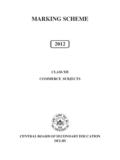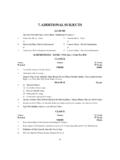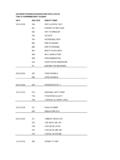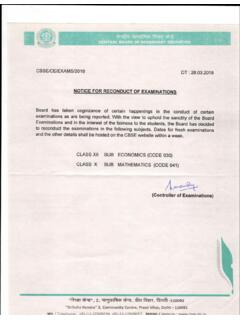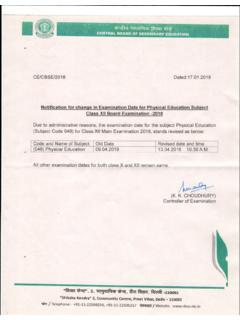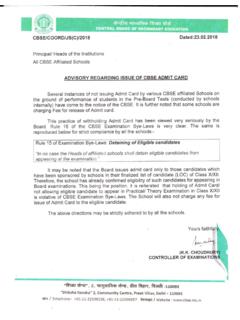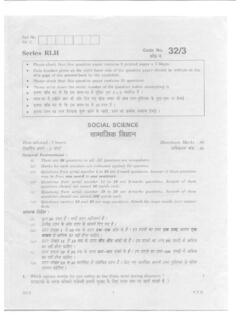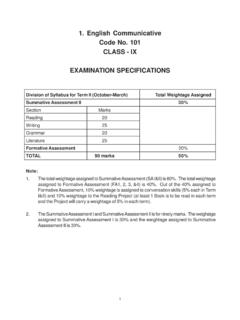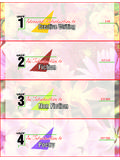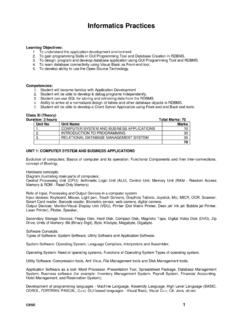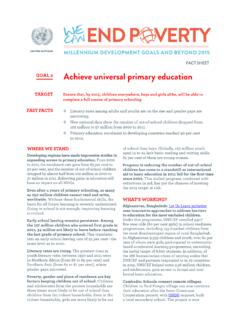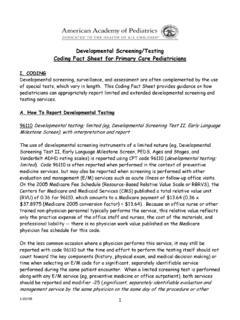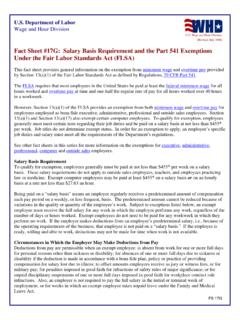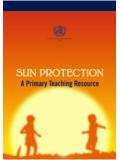Transcription of Grade : 7 Mathematics Laboratory in Primary & Upper ...
1 77 Grade : 7 Mathematics Laboratory in Primary & Upper Primary schoolsGrade : 7 - Mathmatics Laboratory in Primary & Upper Primary schools7785To represent the products of decimal numbers such as (i) x (ii) x on a square Objective :Pre-requisits : Materials Required : Procedure :Step 6. To understand the multiplication of decimal of pens, square paper, pencil and a a square sheet of this square into10 equal parts by drawing horizontal lines as shown in Fig. 1(a). Each part represents 1/10 = 7 parts out of 10 so as to represent as in (b)Now draw, 9 vertical lines on the same paper at equal distances such that each vertical part represents 1/10 or as in (c).Shade 3 vertical parts so as to represent as shown in (d).The double shaded portion represents the product x 1(a)Fig 2(b)ACTIVITY 1 Fig 1(d)Fig 1(c)77 Grade : 7 - Mathmatics Laboratory in Primary & Upper Primary schoolsStep :Follow the above Steps to represent the product x using another square sheet.
2 (i)The square sheet has been divided into .. equal parts.(ii) The number of equal parts in the double shaded portion is ..(iii) The double shaded portion represents the product x ..which is equal to ..(iv) The product x = ..86 Grade : 7 - Mathmatics Laboratory in Primary & Upper Primary schools7787 ACTIVITY 20510152025304035 EnglishMathsHindiScienceSocial ScienceFig 2(a)3532333822253034263077 Grade : 7 - Mathmatics Laboratory in Primary & Upper Primary schoolsMake a double bar graph as shown in fig.(1) taking marks on vertical axis and subjects on horizontal axis.(i) In which subjects there has been a downfall from I term to II term exam? ..(ii) What do you observe from the bar graph about the Marks of II term examination?..(iii)In which subject (in terms of marks) is the improvement from I term to II term(a) maximum? ..(b) minimum? .. (iv) In which two subjects, the increase in marks in II term is the same?
3 Let the students collect the data regarding monthly income and expenditure of their families. Ask them to represent the data using a double bar graph taking data of 5 families at a :Extension : 88 Grade : 7 - Mathmatics Laboratory in Primary & Upper Primary schools7789To verify, by paper cutting and pasting, that if two parallel lines are intersected by a transversal, then (i) each pair of corresponding angles are equal(ii) each pair of alternate interior angles are equal(iii) each pair of interior angles on the same side of the transversal are Objective : Pre-requisite : Materials Required : Procedure :Step establish the properties relating to different pairs of angles formed by a transversal with two parallel and identification of pairs of corresponding angles, pairs of alternate interiors angles and pairs of interior angles on the same side of the of white and coloured papers, a pair of scissors, glue, a geometry box, carbon paper and a two lines l and l parallel to each other and a transversal l intersecting them.
4 123 Label the angles thus obtained by numbers 1 to 8 [Fig. 3(a)].Make a cut out of 1 on a coloured paper placing it below the figure and marking impressions by using carbon paper or tracing the cutout of the angle on 5 and check whether the two angles cover each other or that these angles make a pair of corresponding 3l1l2l312345678 Fig 3(a)46 Fig 3(b)77 Grade : 7 - Mathmatics Laboratory in Primary & Upper Primary schools90 Grade : 7 - Mathmatics Laboratory in Primary & Upper Primary schools7791(a) To get a median of a given triangle from any vertex by paper folding and to verify that in a triangle, medians pass through a single point.(b) To get an altitude of a given triangle from any vertex by paper folding and to verify that in a triangle altitudes pass through a single Objective :Pre-requisite :Materials Required : Procedure : (a)Step 5 To understand the concept of a median and an altitude of a with elements of triangles (vertices, sides and angles), types of triangles.
5 Knowledge of median and altitude of a trangle, skill of paper papers, a pair of scissors, coloured pencil, a out a triangular shape from a thick paper and name it as ABC [Fig. 4(a)].Fold the side AC on itself so that vertex C falls on vertex A. Mark the point of intersection of the line of fold with AC as P [Fig. 4(b)]. P is the mid point of , find mid points of sides AB and BC and mark them as Q and R respectively [Fig. 4(b)].Now fold the triangular cut out to create a crease along BP. The crease thus obtained is the median from vertex B on the side AC. [Fig. 4(d)].Similarly, get medians from vertex A and C as AR and CQ. [Fig. 4(d)].Fig 4(c)ABPCACBACBPFig 4(a)Fig 4(b)ACTIVITY 4QR77 Grade : 7 - Mathmatics Laboratory in Primary & Upper Primary schools92 Observations :Procedure : (b)Step The medians of a triangle ABC are ..2. The medians pass through a .. Are all the medians of same length?
6 (Yes/No)Cut out a triangular shape from a thick paper and name it as MNO. [Fig. 4(e)].Fold this cut out through the vertex M in such a way, that side ON falls along it self. Mark the crease as MP [Fig. 4(f)]. MP is an this triangular cut out again through the point N such that the side OM falls along itself and obtain the crease as NQ [Fig. 4(g)]Similarly, obtain the third crease OR [Fig. 4(g)].Fig 4(D)ABCQRPFig 4(e)NMOFig 4(f)NMOPFig 4(g)NMOPRQG rade : 7 - Mathmatics Laboratory in Primary & Upper Primary schools77 Observations :Extension :1. The attitudes of the triangle MNO are ..2. The altitudes pass through a .. Are all the altitudes of same length? .. (Yes/No)1. Medians of all types of triangles can be obtained by repeating the procedure (a).Explore which triangle has all the three medians Altitudes of all types of triangles can be obtained by repeating the procedure (b).Explore which triangle has all the three altitudes : 7 - Mathmatics Laboratory in Primary & Upper Primary schools94 ACTIVITY 5 Fig 5(c)Fig 5(a)123123 Fig 5(b)PFig 5(d)BC ADBCADBCAG rade : 7 - Mathmatics Laboratory in Primary & Upper Primary schools77 Observations : (i)Three angles 1, 2 and 3 in Fig.
7 5(b), form a an .. angle (acute / right / obtuse / straight)(ii) The sum of the angles of a triangle is .. 180 (less than / equal to / more than).(iii) In Fig. 5(c) ABD is an .. angle and BAC and BCA are two .. angles.(iv) .. ABD = Sum of two interior .. angles BAC and ..(v) ABD = BAC + ..9577 Grade : 7 - Mathmatics Laboratory in Primary & Upper Primary schools96 ACTIVITY 65 cm7 cm11 cmFig 6 (a)7 cm5 cm11 cmFig 6 (b) Grade : 7 - Mathmatics Laboratory in Primary & Upper Primary schools7797 Observations :For Set 1:For Set 2:For Set 3:[See Fig. 6(b)]5 + 7 > 11 ..5 + 11 > ..7 + 11 > ..Triangle can .. (be formed / not be formed) [See Fig. 6(c)]7 + 14 > 55 + 14 > ..5 + 7 ..14 Triangle can .. (be formed / not be formed) [ See Fig. 6 (d)]7 + 12 > 5 ..5 + 12 > ..7 + 5 .. 12 Triangle can .. (be formed / not be formed) Thus, a triangle can only be formed when sum of the length of its two side is.
8 Than the third cm5 cm12 cmFig 6 (d)7 cm5 cm14 cmFig 6 (c)77 Grade : 7 - Mathmatics Laboratory in Primary & Upper Primary schools98To verify Pythagoras Objective :Pre-requisite : Materials Required : Procedure :Step 5. To understand property of a right of area .Squared papers, sketch pens of different colours, paper and a right angled triangle ABC of sides say 3, 4 and 5 units on a squared paper. [Fig. 7(a)]Make a square on side BC (3 units) and a square on the side AB (4 Units) as shown in [Fig. 7(b)].Also make a square of side 5 units on a squared paper of the same type and cut it this cut out square along the side AC of the triangle as shown in the Fig. 7 (c).Count the number of unit squares in each of these three squares on AB, BC and 7 Fig 7(c)ABC453 Fig 7(a)ABCFig 7(b)ABCG rade : 7 - Mathmatics Laboratory in Primary & Upper Primary schools77 Observations :Extension :(i)Number of unit squares in the square on side AB =.
9 (ii) Number of unit squares in the square on side BC = ..(iii) Number of unit squares in the square on side AC = ..(iv) Sum of unit squares in the squares on sides AB and BC = ..Number of units squares on side AC = Sum of number of unit squares on sides .. and ..(v) Square on the hypotenuse of a right triangle = Sum of the squares on the other .. sides of the (i)Draw a triangle of dimensions 4 units, 5 units and 6 units. Is 4 + 5 = 6 ? (Yes/No)Is the angle opposite to side 6cm a right angle? (Yes/No)(ii) The above activity can also be performed by pasting the square of side 4 units on the square of side 5 units, at one of the corners. Then fill the remaining space by cutting and pasting the unit squares of side 3 : 7 - Mathmatics Laboratory in Primary & Upper Primary schools100(a)To verify by paper cutting and superimposing that diagonal of a parallelogram divides it into two congruent triangles.
10 (b)To verify using a squared paper that all congruent triangles are equal in area but the triangles equal in area may not be triangle ADC completely cover ABC?Learning Objective :Pre-requisite: Materials Required :Procedure :Step :Procedure : Step :(1) To understand that diagonal of a parallelogram divides it into two congruent triangles.(2) To understand that all congruent triangles are equal in area but the triangles equal in area may not be of a parallelogram and its a diagonals. Idea of congruent papers, a ruler, sketch pens and a pair of scissors.(a)Take a squared a parallelogram ABCD on it. [Fig 8(a)]Join diagonal AC. [Fig. 8(b)]Cut out the parallelogram the parallelogram along the diagonal AC. [Fig. 8(c)]Place the triangle ADC on ABC such that AD coincides with CB and CD coincides with the activity by cutting across the other diagonal BD of the parallelogram ABCD and superpose one triangle on the other.
